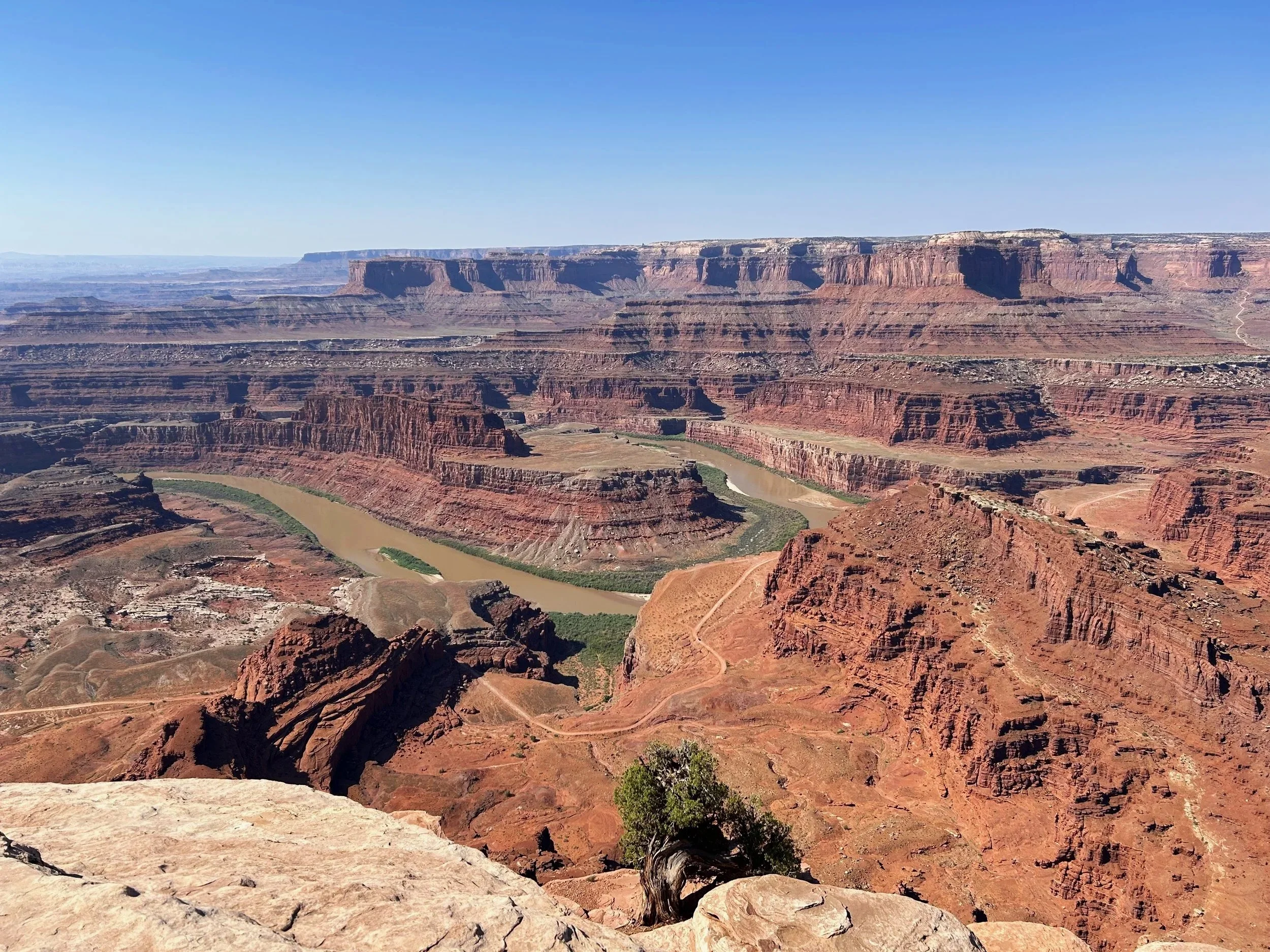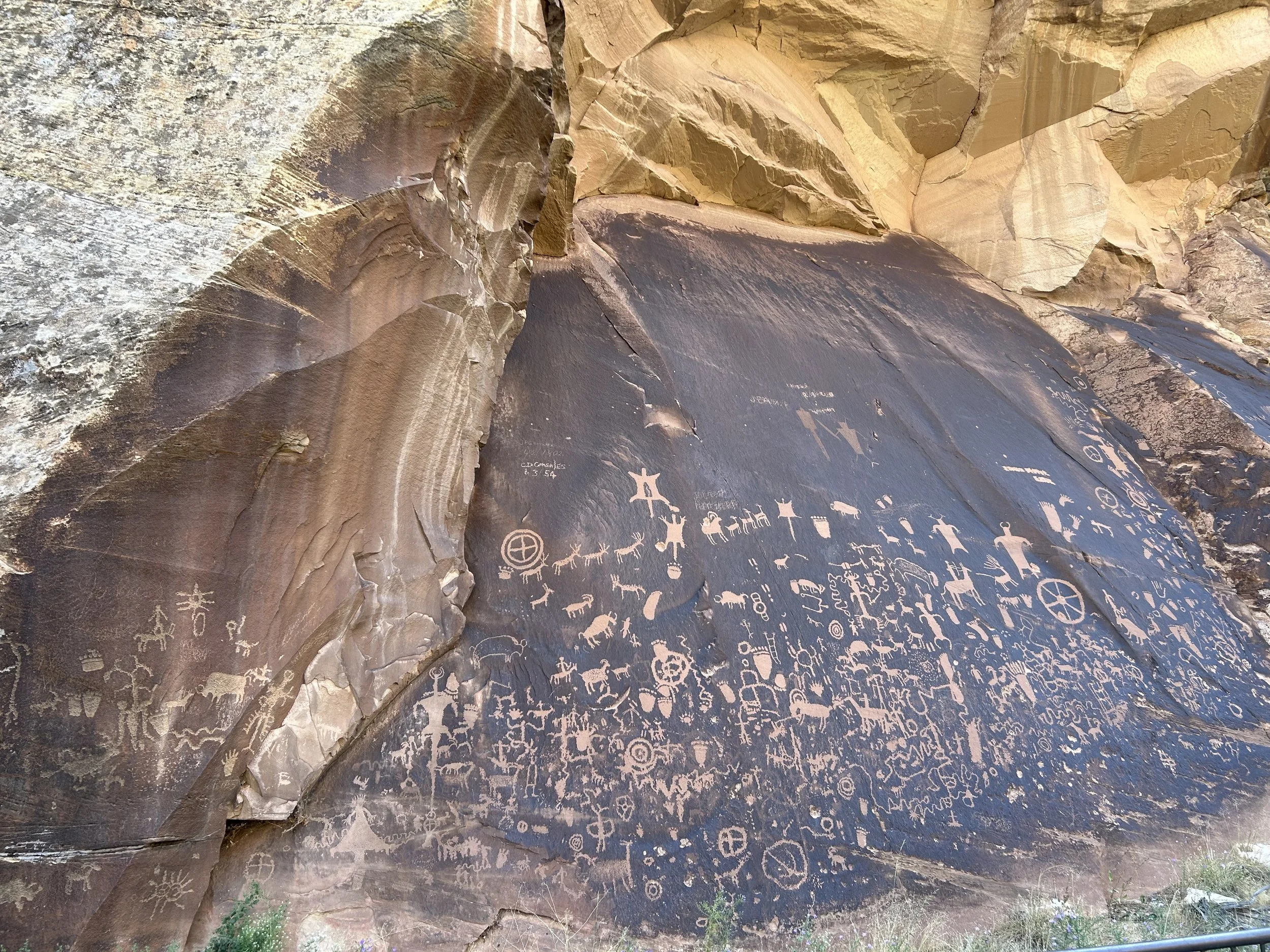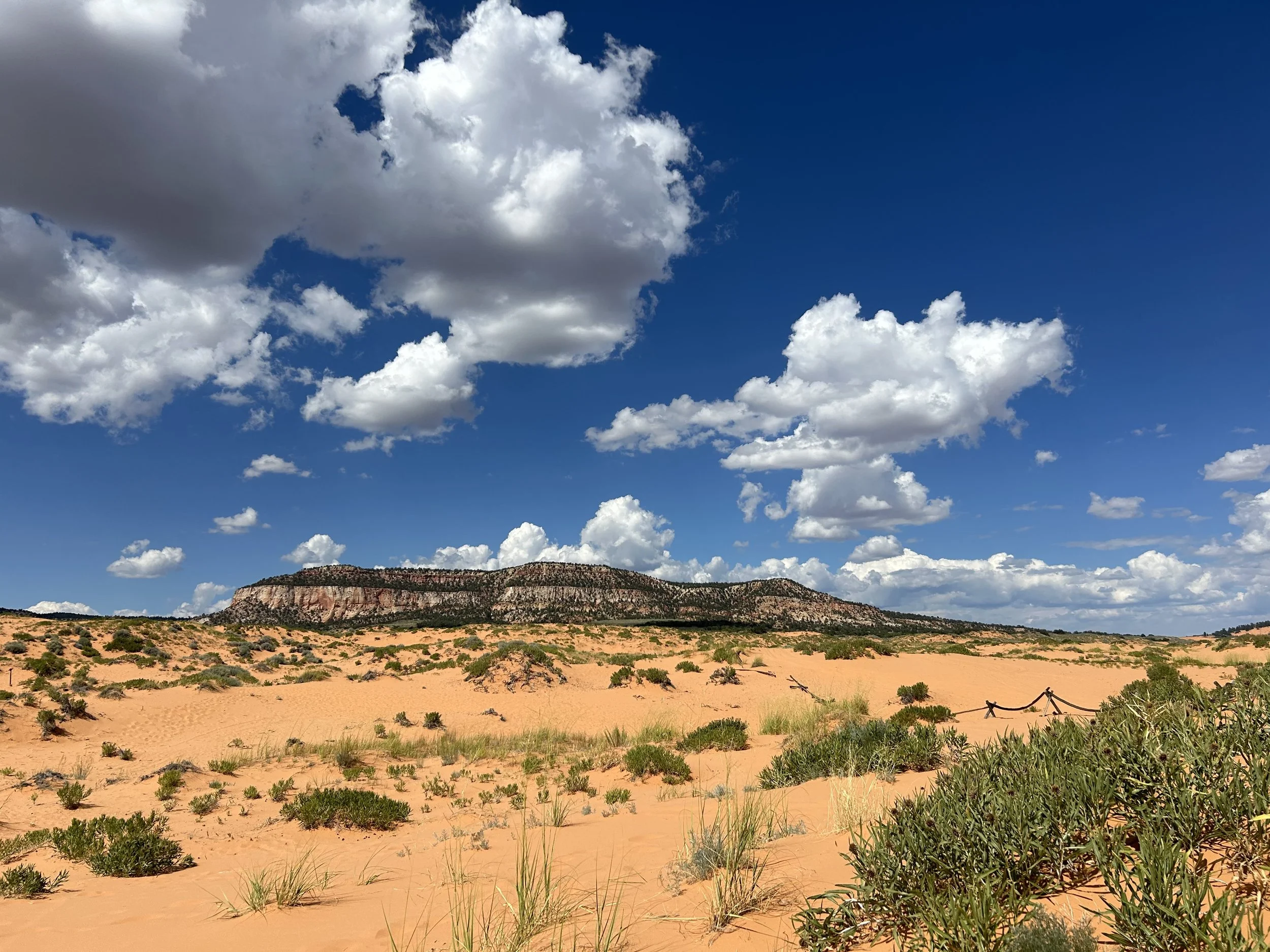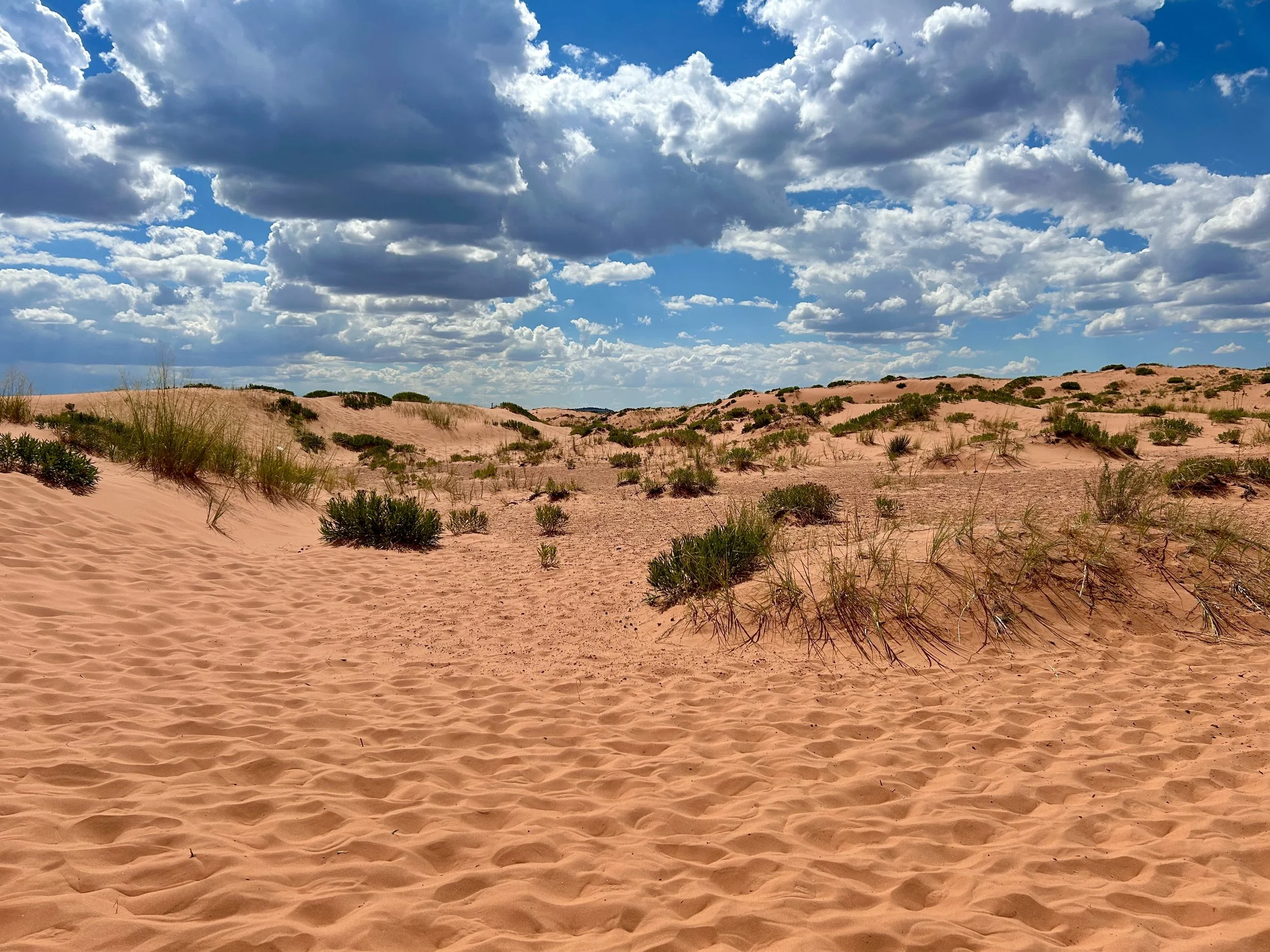Dead Horse Point State Park and the Colorado River
This is the seventh post in my series about our trip last year to Utah. If you missed the other posts, click here to start.
If you’ve been following along in this series, you’ve likely been amazed, along with me, by the sites we saw in Utah. Of all the photos and places from our trip that I’ve shared with you, I took hundreds more photos and we visited a handful more places.
And of course, there’s so much more to explore in Utah than what we did.
This is my last post about our trip. I wanted to wrap up the series by telling you about two state parks and a major petroglyph site that we visited.
Newspaper Rock
The morning that we headed to Canyonlands National Park, we drove along the Indian Creek Corridor Scenic Byway and stopped first at a site called Newspaper Rock. After a very short trail, we came upon a 200-square-foot rock covered in petroglyphs drawn and engraved by Native Americans for 2,000 years. More than 650 figures on the rock include humans as well as animals of all kinds, tools, circular symbols, and more. According to the website, they were created “by pecking through the black desert varnish found on the rock to the lighter rock beneath.”
Side view of Newspaper Rock
Who were the artists? Peoples from the Fremont, Ute, and Anasazi Native American tribes. They came to this area, probably drawn by the water of a natural spring, and while they were here, they etched their art on this rock, which is known in Navajo as the “rock that tells a story".
Coral Pink Sand Dunes State Park
On the afternoon that we saw Zion Canyon, we drove back to Kanab, where our rental house was, and stopped at the Coral Pink Sand Dunes State Park. We’d passed the sign several times during our stay and decided to check it out.
We drove through the park for about 15 minutes until we came to the park ticket booth. As we pulled up, a sign outside the booth said, “Today’s temperature on the sand is 118 degrees.”
Wait—what? 118?
The park ranger in the booth confirmed that it was, in fact, true. She gave us a brochure and some tips on how to not spontaneously combust.
It was already so hot, I wasn’t sure this was a good idea, but we really wanted to see the sand dunes. So we parked, reloaded on water and sunscreen, and took a deep breath (or, at least, I did).
Fortunately, it was a short trail to the deck looking out over the dunes. One of the park signs there read, “Coral Pink Sand Dunes are the only major dune field in the Colorado Plateau region of the southwest. Tucked along the Vermilion Cliffs, the dune field stretches for seven miles.”
Another sign explained why the dunes exist here. The sand comes from the erosion of Navajo sandstone cliffs to the south. When the wind funnels through a notch those mountains, it creates a wind tunnel, picking up and carrying sand along with it. After passing through the notch into the open valley, the wind’s velocity dies down and drops the sand. But the wind is constantly bringing more.
Plants do grow here, but they have to be tough to handle the constantly shifting sands. So they send out underground seedlings that sprout new stems and leaves. That way, if the parent plant gets buried by sand, the plant can still survive through the seedlings.
Though it was breezy, the wind was hot, and so was the sand. Leaving the deck, we walked down into it. I couldn’t believe the effort it took. My feet felt heavy, and I had to stop often and take a deep breath.
I have never been so hot in my entire life. Ever. I felt like I was in an old Western movie, lost in the desert, with no water. When we finally got back to the parking lot, I was very glad that our car wasn’t a mirage, the AC worked really well, and my water bottle was full.
Dead Horse Point State Park
On our last day of touring, we stopped off at Dead Horse Point State Park. Some friends had told us that in all of their RV rambles, their favorite site to camp was Dead Horse Point (see the photo at the top of this post). Our friends live in Colorado and travel quite a bit, so we knew right away that we needed to see this place.
another view
The majestic view at Dead Horse Point State Park was formed by sediments deposited by ancient seas, freshwater lakes, streams, and wind-blown sand dunes, says the website. Plants and animals here have adapted in order to survive the hot, dry desert. Animals are typically nocturnal so they can avoid the high daytime temperatures, and their large ears help release heat from their bodies. Plants grow very slowly; some of the trees may be hundreds of years old.
Of course, you’re wondering: why the name? Legend has it that around the turn of the century, cowboys would corral mustangs here on a narrow bit of land, called the Neck, that connected the mesa with a peninsula of rock on top of sheer cliffs. The peninsula is the Point. Apparently, one time, the horses corralled there were left too long, where sadly they died of thirst.
Yes, this rock wall and its sand are green, which is caused by reduced iron minerals.
The sad name notwithstanding, we enjoyed our time at Dead Horse Point State Park. Our friends had told us that the sunsets are spectacular, but we couldn’t stay. We were on our way to Salt Lake City to fly home the next day.
The beauty in Utah alternately stunned me and surprised me. I’ve never seen so many strange rock formations, waves of canyons, or vibrant colors in cliffs and sand. Over and over, I was filled with awe at what I saw. And the wonder I felt at that beauty pointed me, again, to God as master creator and designer. My heart overflowed with gratitude and thanksgiving. How could it not, when it’s clear that God loves beauty and shares it with everyone—everyone, whether they believe in him or not.
When was the last time you were stunned and surprised by beauty in nature? I’d love to know. Please leave a comment below.
If you missed the other posts in my series on Utah, start here.
Are you receiving my blog posts by email? Here at Glimsen, I share glimpses of the beauty around us in nature, the arts, and the unexpected. If you would like to see more, click the button below to receive my posts and updates by email, and you'll also get a free printable gift of beauty in your inbox. I look forward to connecting with you!









